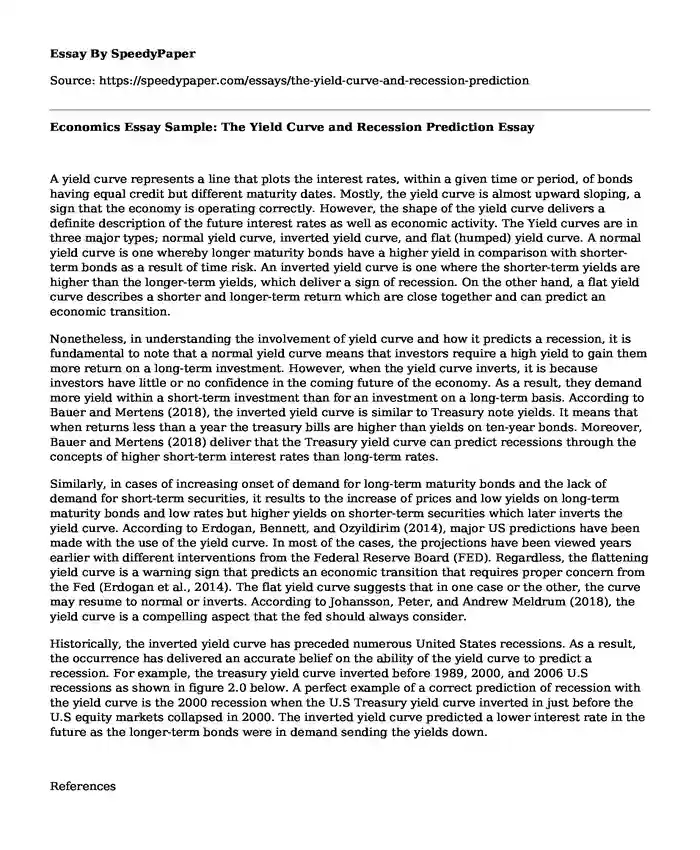A yield curve represents a line that plots the interest rates, within a given time or period, of bonds having equal credit but different maturity dates. Mostly, the yield curve is almost upward sloping, a sign that the economy is operating correctly. However, the shape of the yield curve delivers a definite description of the future interest rates as well as economic activity. The Yield curves are in three major types; normal yield curve, inverted yield curve, and flat (humped) yield curve. A normal yield curve is one whereby longer maturity bonds have a higher yield in comparison with shorter-term bonds as a result of time risk. An inverted yield curve is one where the shorter-term yields are higher than the longer-term yields, which deliver a sign of recession. On the other hand, a flat yield curve describes a shorter and longer-term return which are close together and can predict an economic transition.
Nonetheless, in understanding the involvement of yield curve and how it predicts a recession, it is fundamental to note that a normal yield curve means that investors require a high yield to gain them more return on a long-term investment. However, when the yield curve inverts, it is because investors have little or no confidence in the coming future of the economy. As a result, they demand more yield within a short-term investment than for an investment on a long-term basis. According to Bauer and Mertens (2018), the inverted yield curve is similar to Treasury note yields. It means that when returns less than a year the treasury bills are higher than yields on ten-year bonds. Moreover, Bauer and Mertens (2018) deliver that the Treasury yield curve can predict recessions through the concepts of higher short-term interest rates than long-term rates.
Similarly, in cases of increasing onset of demand for long-term maturity bonds and the lack of demand for short-term securities, it results to the increase of prices and low yields on long-term maturity bonds and low rates but higher yields on shorter-term securities which later inverts the yield curve. According to Erdogan, Bennett, and Ozyildirim (2014), major US predictions have been made with the use of the yield curve. In most of the cases, the projections have been viewed years earlier with different interventions from the Federal Reserve Board (FED). Regardless, the flattening yield curve is a warning sign that predicts an economic transition that requires proper concern from the Fed (Erdogan et al., 2014). The flat yield curve suggests that in one case or the other, the curve may resume to normal or inverts. According to Johansson, Peter, and Andrew Meldrum (2018), the yield curve is a compelling aspect that the fed should always consider.
Historically, the inverted yield curve has preceded numerous United States recessions. As a result, the occurrence has delivered an accurate belief on the ability of the yield curve to predict a recession. For example, the treasury yield curve inverted before 1989, 2000, and 2006 U.S recessions as shown in figure 2.0 below. A perfect example of a correct prediction of recession with the yield curve is the 2000 recession when the U.S Treasury yield curve inverted in just before the U.S equity markets collapsed in 2000. The inverted yield curve predicted a lower interest rate in the future as the longer-term bonds were in demand sending the yields down.
References
Bauer, M. D., & Mertens, T. M. (2018). Economic Forecasts with the Yield Curve. FRBSF Economic Letter, 7.
Erdogan, O., Bennett, P., & Ozyildirim, C. (2014). Recession prediction using yield curve and stock market liquidity deviation measures. Review of Finance, 19(1), 407-422.
Johansson, Peter, and Andrew Meldrum. (2018). "Predicting Recession Probabilities Using the Slope of the Yield Curve." FEDS Notes, Federal Reserve Board of Governors, doi.org/10.17016/2380-7172.2146
Cite this page
Economics Essay Sample: The Yield Curve and Recession Prediction. (2022, Sep 23). Retrieved from https://speedypaper.net/essays/the-yield-curve-and-recession-prediction
Request Removal
If you are the original author of this essay and no longer wish to have it published on the SpeedyPaper website, please click below to request its removal:
- Free Essay Example on the Anonymous Group
- Essay Example about Infection Control Nurses
- Essay Example about the Discrimination on the African American in the United States
- Free Essay Dedicated to Ecological Social Work
- Essay Example on Personal and Career Plan
- Essay Example Dedicated to Customer Feedback System
- The Case Study: CSR Reputation of Intel Corporation
Popular categories





